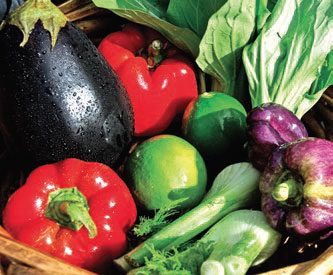The farm-to-fork movement is nothing new to Hawai`i Island. During World War II, many local farmers expanded their fields to provide fresh food to the 50,000 troops who were suddenly stationed in Waimea. Then, with the surge of new resorts on the island in the 1960s, ‘70s, and ‘80s, chefs began to work closely with Hawai`i Island farmers, ranchers, and fishermen to supply their restaurants and the growing tourism industry. But it is clearly a two-way street, as the growers, ranchers, and fisherman have also come to rely on strong resort and restaurant ties for their livelihood.
Owners Kurt and Pam Hirabara supply greens for signature salads at Sansei. On less than two acres, Hirabara Farms in Kamuela manages to produce 13 types of lettuces, at a remarkable rate of 350 pounds a day.
 Nakano Farms, run by Richard and Patsy Nakano, produces mainly tomatoes, but also Korean cucumbers, haricot verts, sweet corn, and melons in Kamuela. Their products are used at Sansei Seafood, Steak & Sushi Bar and other local establishments. And the Hodson family at WOW Farms in Waimea grow mainly organic tomatoes (including Mahiki heirlooms) on their 10 acres of Hawaiian Homestead land, and are known for producing some of the tastiest tomatoes in the state. WOW products are used in local restaurants and available at farmers markets for home chefs to use and enjoy.
Nakano Farms, run by Richard and Patsy Nakano, produces mainly tomatoes, but also Korean cucumbers, haricot verts, sweet corn, and melons in Kamuela. Their products are used at Sansei Seafood, Steak & Sushi Bar and other local establishments. And the Hodson family at WOW Farms in Waimea grow mainly organic tomatoes (including Mahiki heirlooms) on their 10 acres of Hawaiian Homestead land, and are known for producing some of the tastiest tomatoes in the state. WOW products are used in local restaurants and available at farmers markets for home chefs to use and enjoy.
As for seafood, many chefs (including Lutey at Sansei) use Kona Fish or Kona Cold for the freshest catch imaginable. Among the plethora of local fish they provide are ahi, ono, mahimahi, opah, kampachi, swordfish, opaka, moi, as well as lobster, shrimp, and abalone.
In the end, of course, it’s diners who reap the tasty benefits, a fact reinforced every time they dine at a local restaurant or whip up a tasty meal at home … and as the Hawai`i Food & Wine Festival will once again clearly demonstrate in late August.

